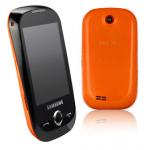Samsung Genio Touch Review
It’s clear that the feature phone market is still dead-set on emulating the cutting edge that is smartphones. The Genio Touch, as demonstrated by its name, is a touch sensitive phone that endeavours to be as much like its bigger brothers as possible without becoming unnecessarily expensive or, even, evolving any features you wouldn’t ordinarily find in a feature phone.
I’ve been detached from the feature phone market for so long that to review one is probably not sensible, but I’ll give it a go anyway. I’ve never really liked feature phones of any level of complexity, favouring the tough Sonim XP3 for its combination of durability, reliability and simplicity… if I were confined only to feature phones then that’s surely the path I would take.
The Genio Touch’s main selling point is, unsurprisingly, its reintroduction of interchangeable covers. However, unlike the horrible phones of yore and old which sported detachable faceplates the Genio Touch cheats slightly by simply making available a variety of multi-coloured replacement battery covers. Of course, the battery cover does occupy the entire back of the phone making this a sensible concept, but is there really any need to offer this level of customisability?
I received an Orange branded Genio Touch for review which, of course, means that it came with a variety of faceplates themed rather garishly in combinations of the colour orange. This is fair enough if you actually like orange outside of Lotus Elise paint-jobs, but means you’ll be immediately forking out for additional back covers if you don’t. Unfortunately the buttons on the side of the phone are also orange, and they’re impossible to replace- meaning that when you ultimately put an obnoxiously bright pink and black back cover on your Genio Touch you’ll be treated to a clash of colours so complete that your phone would be practically theft proof. Seriously, it’s hard to steal a phone when your eyes are bleeding.
Anyway, suffice to say that if you’re not a particular fan of the colour orange, or colours that compliment it (like black, and..err.. black) then you’ll be wanting to pick up an unbranded Genio Touch elsewhere where your initial choice of back-cover colour will also decide the button colour and limit sensible, non clashing replacements. Oh dear.
Right, over to the software. The Genio Touch is, perhaps, one of the first cheap feature phones to come with a capacitive touch screen- IE: the same touch screen technology you would expect to find on the iPhone. This makes quite sensitive and in theory should make it more responsible, however the software isn’t quite up to the job.
The Genio Touch attempts to create a multi-pane widget driven touch screen, not unlike those of Android phones. Unfortunately the level of responsiveness is dire and there’s no “edit” mode to separate widget drag attempts from desktop switching, meaning you’ll have to leave some desk space clear for switching. The touch screen isn’t terribly responsive for a capacitive screen, but it’ll certainly feel better than resistive to anyone who isn’t used to it.
Feature phones perplex me. They’re a bit like chinese knock-offs of games consoles in that they do their best to emulate the look and feel (ha!) of a powerful, feature packed device but utterly fail to deliver. That said, it’s unfair to say the the Genio Touch is to the iPhone what the Popstation is to the PSP. For what seems to be a shallow imitation of a smartphone, the Genio Touch actually has a lot of substance, the capacitive touch screen is a bonus, the widget driven desktop is a functional but slightly half-assed nod toward the home screens of the Android and Maemo operating systems, and it looks like a colourful first generation HTC Touch.
On the downside it has no physical keypad, no slide-out keypad, and relies on an onscreen representation of a traditional number pad for text messaging- I hate these and can barely muddle my way through a text using one… why on earth they didn’t include a full keyboard when it’s entirely virtual perplexes me. Lack of screen real estate might be the problem, but surely even a landscape orientated, nearly full-screen keyboard with a little SMS box at the top would have been a preferable steal from the smartphone world.
Of course, lack of any real internet or social networking access makes this a problem that affects only text messaging, which is normally done surprisingly efficiently using the convoluted number-pad text input method that has been perfected by feature phone sporting teens the world over with a degree of aptitude that I can only look upon an envy.
So, the Genio Touch will give you a little taste of the smartphone world that will leave you wanting more, and looking wistfully upon the expensive iPhone 3Gs and plentiful Android phones. It’s a good worthy bridge phone, that will introduce you to some smartphone concepts but ultimately if you’re interested in anything other than the interchangeable back plates (and even those, as I mentioned, aren’t particularly exciting) then you’re going to want to look at the Motorola DEXT instead, a handset that embodies everything the Genio Touch tries and fails to be and represents the true bridge between high-end feature phone and low-end smartphone. It also has a keyboard, remember those? They have a key for each letter! What will they think of next.
